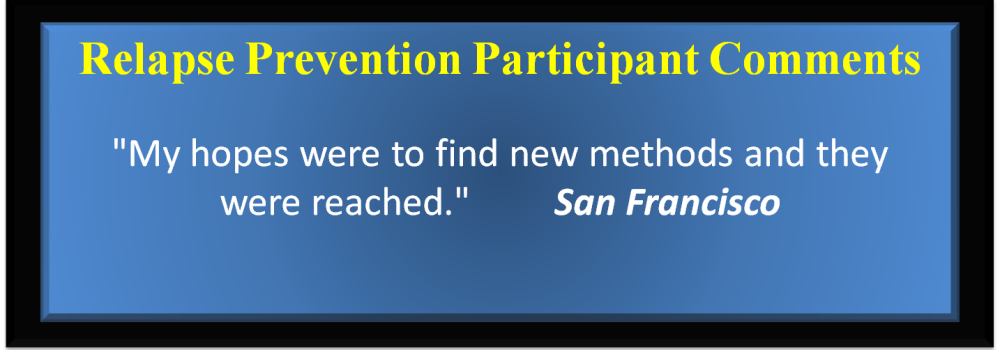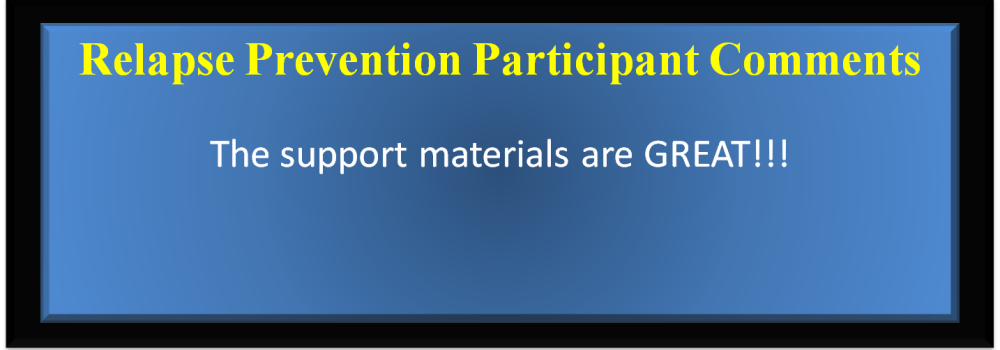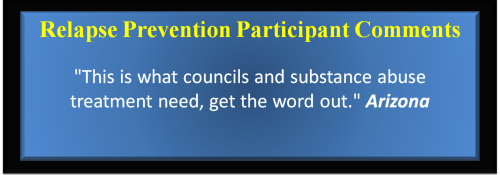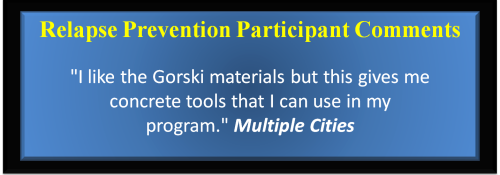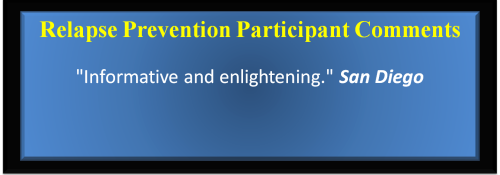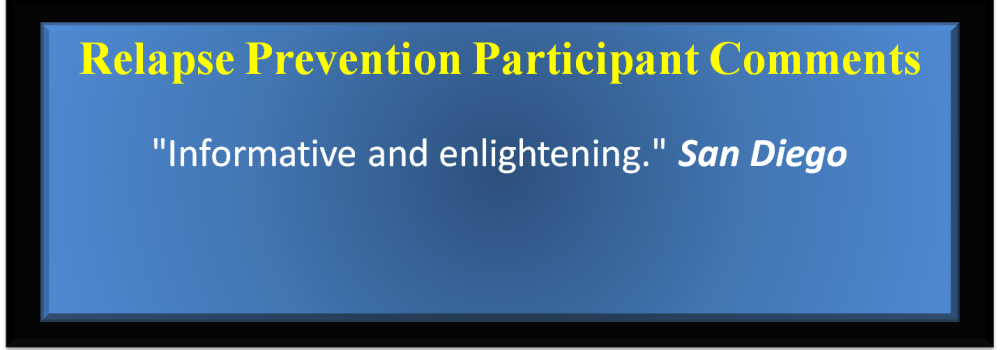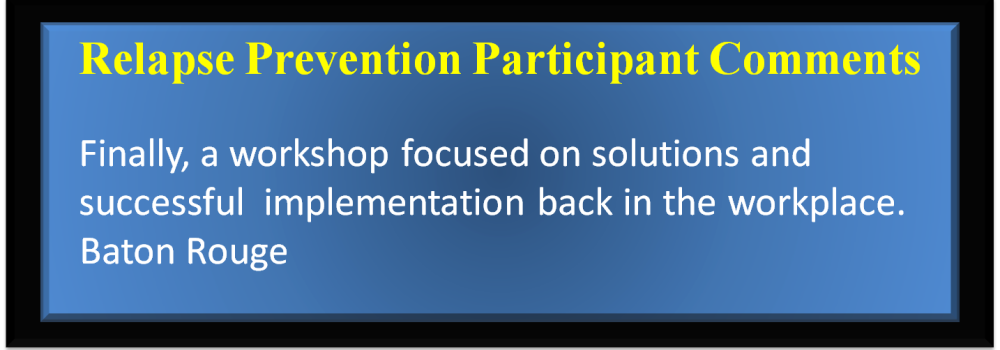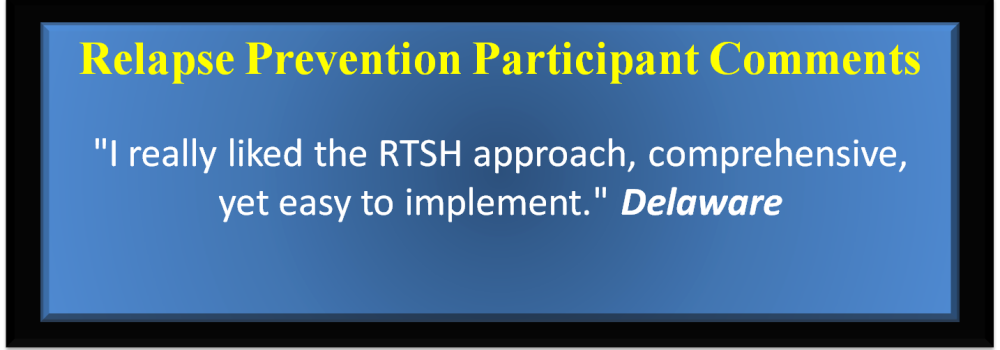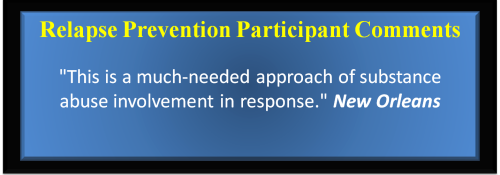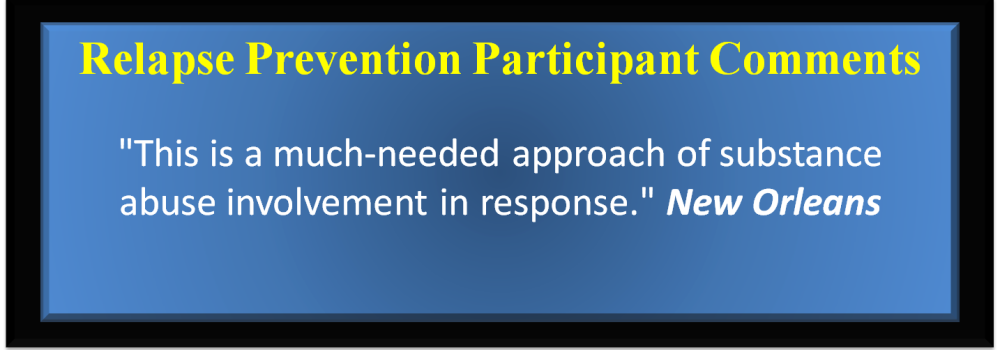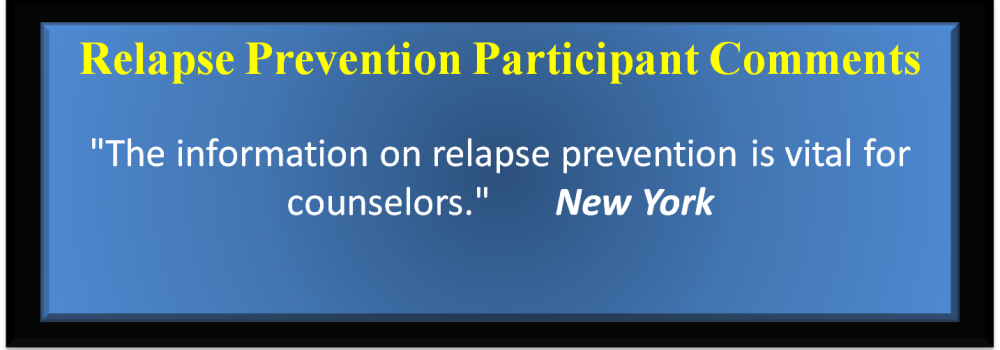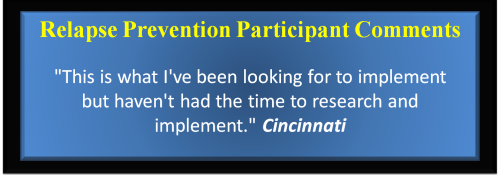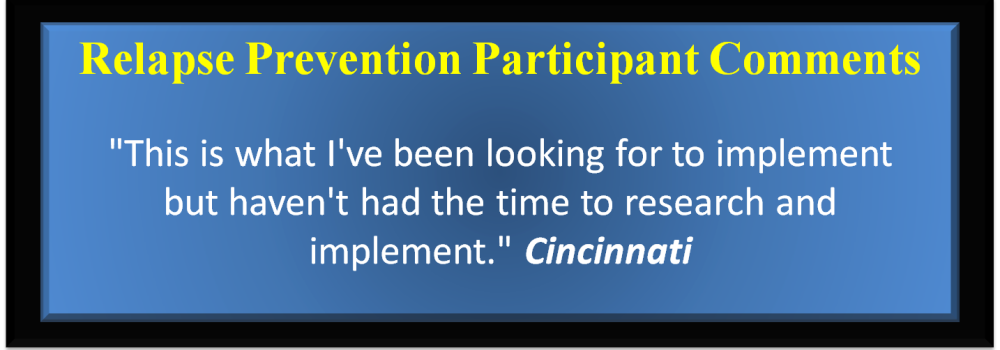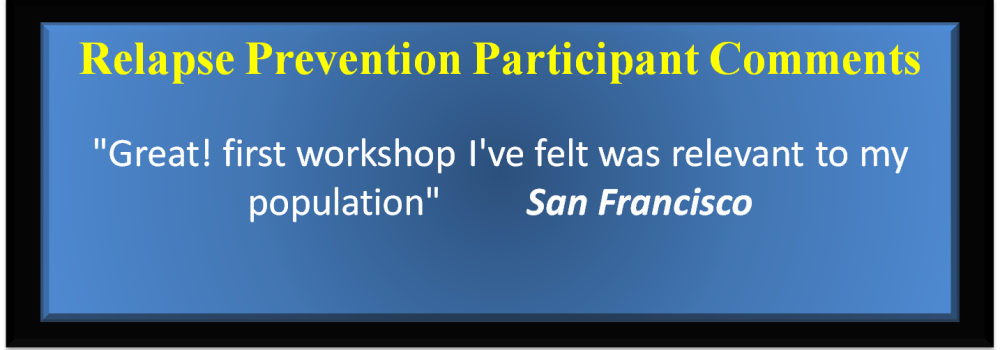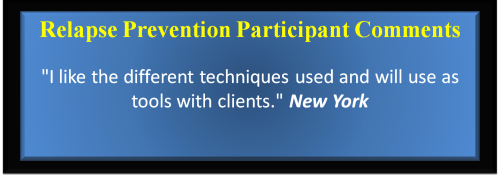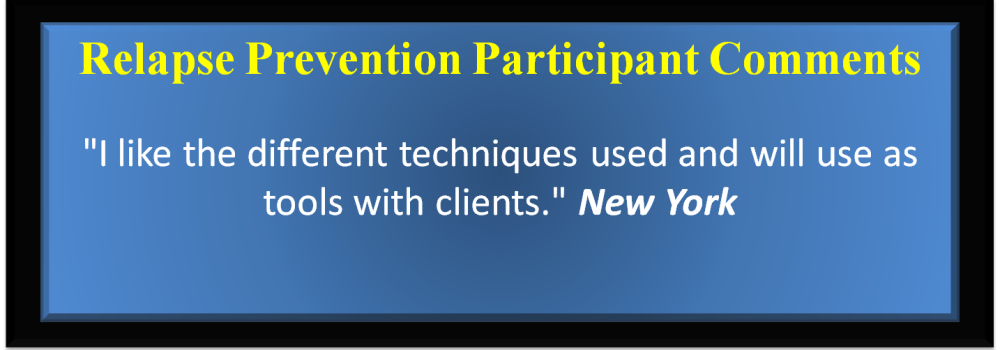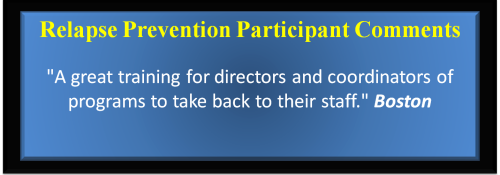Relapse continues to be a very serious problem facing the substance use, mental health and criminal justice fields. Research suggests that nearly half of all chemical dependency clients relapse at least once. Many of these clients are not in denial, acknowledge their addictions and want to change their lives so they can stay off drugs. The problem is that they do not know how to do so, resulting in an inability to cope with the numerous temptations to use alcohol and drugs that confront them once they leave treatment. Clearly, relapse is a real threat and is too important to be ignored. Despite the prevalence and importance of the problem many treatment agencies and drug courts DO NOT have a specific relapse prevention track for clients, or are not using proven and effective relapse prevention approaches.
National Institute on Drug Abuse (NIDA) Two Proven & Effective Approaches
Recovery Training and Self Help (RTSH for the Treatment of Opiate and Heroin Addiction
Recovery Training and Self-Help (RTSH) is a comprehensive relapse prevention strategy. It combines four strategies, and can be used effectively in the context of continued care and/or follow-up counseling services provided in the course of addiction recovery. RTSH can be used as part of either residential or outpatient programs. RTSH employs a group format which combines cognitive – behavioral, social support, and lifestyle change approaches. RTSH enables clients to learn how to identify and deal with specific threats to recovery. The RTSH program teaches individuals self-sustaining alternative responses to these threats. These new responses are elements of a new pattern of behavior, and a recovering lifestyle.
Recovery is not just the cessation of drug use; usually it also demands adjustments to a new way of life within the culture of the larger community. To make a truly new way of life and not just relocate the old one, people need much more than to learn how to avoid people places and things. People must have guidance, acquire new skills, develop new relationships and become part of supportive communities. Clients can find support for that emerging lifestyle by participating in four distinct sets of activities that make up the RTSH program. More Information on RTSH
Cue Extinction
Cue Extinction is a relapse prevention technique based on traditional learning and behavioral modification theories that has been empirically tested and, when incorporated into a comprehensive relapse prevention program has been found to be effective in supporting clients to maintain recovery.
The Cue Extinction program teaches techniques that help clients coping with cravings produced by drug-related stimuli until the power of these cues to evoke the craving is reduced or eliminated, even when confronted with the situations and stimuli that triggered the urge in the past. It can be used effectively on an outpatient as well as in a controlled residential program.
Cue Extinction simulates a temporary craving for drugs by having clients recall and describe situations that have made them want to use drugs in the past. By repeatedly exposing clients to their own personal triggers, and teaching them tools for dealing with the cravings that arise from these triggers without letting them resort to using drugs. The program causes cravings gradually to weaken and possibly even disappear. More Information on Cue Extinction
Why are these to relapse prevent approaches recommended over others?
A variety of relapse prevention approaches are currently in use around the country. Among them are approaches based on cognitive behavioral, social support, 12 step, lifestyle change, cure extinction and pharmacotherapeutic techniques.
The two approaches in the NIDA Relapse Prevention Package were chosen because careful scientific testing have proven that, they work: they help recovering persons stay off drugs. Treatment programs that are committed to approaches such as NA and AA will find that the two approaches recommended here are compatible with them.
Materials to Support the Transfer and Maintenance of Learning in the Workplace.
Participants attending the workshop receive the support materials listed below. These materials are valuable resources that will help treatment programs successfully implement and maintain the approaches.
An Introduction to Relapse Prevention, which discusses the nature and causes of relapse, gives reason for doing relapse prevention, and describes the two tested relapse prevention approaches.

The Recovery Training and Self Help: Relapse Prevention and After Care Manual. Provides specific instructions on how to organize and implement RTSH. It addresses problems that service providers are likely to encounter and describes how to address them. Each of the 24 curriculum units is presented in detail, including session objectives, background information on the unit topic, key points, suggested format for group meeting, and the handouts for each unit. It is an incredibly valuable resource.

Administrator Manuals; The administrator guides (pictured below) for each approach discuss administrative and planning issues that program managers interested in adding relapse prevention to their programs should consider. These issues include staff training, fitting relapse prevention into the limited time most programs have to work with clients, and adjusting the model to fit specific program philosophies.

Cue Extinction Handouts; The Six Cue Extinction Tool Scripts, Identifying Urges and Triggers Script, Coping With Craving Ratiing Forms, and Urge and Craving Management Log.

What Are People Saying About the Workshop & the Relapse Prevention Strategies
Recovery Training and Self Help & Cue Extinction
(A Two-Day Skills Based Workshop)
Goal:
To develop and / or enhance the knowledge and skills required to implement two proven and effective models of Relapse Prevention, i.e., Recovery Training and Self Help (RTSH) and Cue Extinction.
Objectives:
- Define Relapse, and identify at least one biological, psychological, and social factor that influences the relapse process.
- Identify and differentiate between the various degrees of relapse along the relapse continuum.
- Understand and explain the role of cravings in the relapse process.
- Differentiate between the assessment of a client’s relapse potential, versus their continued use potential, as defined by the American Society of Addiction Medicine (ASAM).
- Define Relapse Prevention, and identify the key components of relapse prevention programming.
- Identify and define at least two common approaches to Relapse Prevention.
- Identify key components of Marlatt & Gordon’s relapse prevention model.
- Identify at least two factors treatment professionals should consider when responding to a client’s relapse.
- Identify and describe the fundamental concepts that Recovery Training and Self Help (RTSH), a proven and effective Relapse Prevention Approach is based on.
- Identify and describe the four key components that make up the RTSH Relapse Prevention approach.
- Identify at least two key elements of the four key components that make up the RTSH Relapse Prevention approach.
- Identify and define the five parts of a Recovery Training Group
- Identify the primary role of the Recovery Training group leader during each of the Five Phases of the Recovery Training Group.
- Identify at least two common errors group leaders may make when running a Recovery Training Group.-
- Identify the key characteristics of Cue Extinction, a proven and effective Relapse Prevention Approach.
- Identify at least two rationale for using the Cue Extinction Relapse Prevention Approach.
- Identify at least one benefit of using Cue Extinction.
- Identify and Explain the elements of conditioning and conditioned response in relation to drug addiction and recovery.
- Identify and describe the six Cue Extinction tools.
- Identify and order the steps involved in the Cue Extinction Process.
- Identify and explain the steps involved in helping a client identify triggers that might induce drug craving.
- Identify at least two Benefits of Using the Coping with Craving (CWC) Rating Scale.
- Identify two potential problems that could interfere with, or prevent the successful implementation of a Cue Extinction counseling session.
- Identify at least two ways for dealing with clients who may still be experiencing urges and cravings after the Cue Extinction Tool has been applied.
- Identify the challenges and barriers to successful implementation of the two approaches.
Job / Career Relevancy
While many agencies address relapse as part of the standard milieu of treatment incorporating bits and pieces of various relapse prevention strategies into individual counseling and group work, fewer actually run groups or have tracks dedicated solely to relapse prevention. Many organizations are looking for qualified staff to implement and run proven and effective Relapse Prevention programs. Possessing the knowledge and skills to implement proven and effective relapse prevention approaches is a marketable skill that you can take with you wherever you work, and one that should be listed on your resume.


